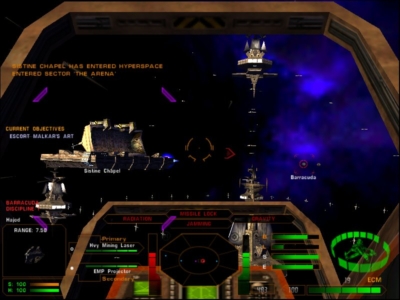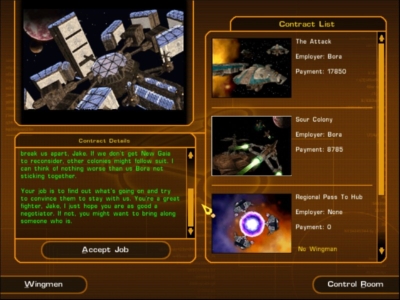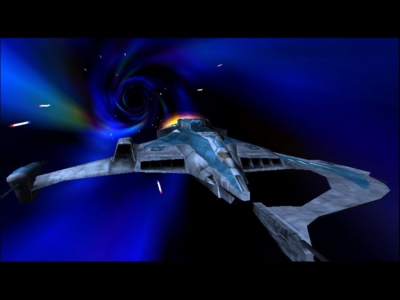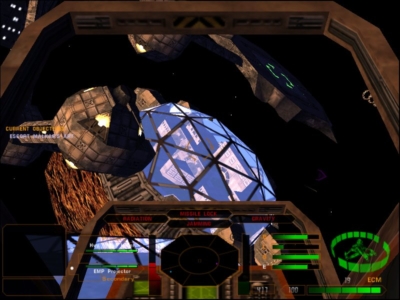
Tachyon: The Fringe
Written by: Rik
Date posted: June 17, 2006
- Genre: Simulation
- Developed by: Novalogic
- Published by: Novalogic
- Year released: 2000
- Our score: 6
In the great book of gaming clichés, one of the oldest and most often used is ‘Recommended for fans of the genre’. We’ve all seen it often enough, tacked on the end of a review of an otherwise unremarkable game, but what the hell does it really mean? Okay, so us jaded gamers have long accepted that such a tag is usually attached to a title that most people wouldn’t think about buying, but which probably wouldn’t make them sick with rage if they did so. And, of course, it makes sense that people who enjoy playing a certain type of game are going to have more fun with a ‘60%’ title than those who, er, don’t. Or does it? Surely, a ‘fan of the genre’ is going to have spent many an hour in front of the very best titles out there, developing nitpicks and criticisms of the market leaders and demanding better next time around – exactly how tolerant are they likely to be of more run-of-the mill titles? Conversely, someone who doesn’t know any better should be more than willing to lap up mediocrity with a big grin plastered across their face. Essentially, it’s a completely meaningless phrase, which tells the reader absolutely nothing about whether they may or may not like something, and used only because it’s a slightly easier and more pleasant way of saying ‘this is not that great’.
Now, I should confess: I haven’t actually played a space sim in a long time. In fact, barring a few disinterested hours ploughing through X-Wing: Alliance‘s early missions, I haven’t really played one since the last Wing Commander game – and that was a while ago. And while I like a good space romp as much as the next man (TIE Fighter rocks etc), I remain largely oblivious to the relative merits of Freelancer, X: Beyond The Frontier and Conflict: Freespace. Despite this, however, it’s fair to say that Tachyon didn’t exactly blow me away. I’m pretty sure that my arrival at this conclusion (apologies if you prefer this to come at the end, by the way) had absolutely nothing to do with my level of space-sim fandom and everything to do with the fact that this game is only ‘quite good’. It’s not great, but neither is it ugly, horrible and offensive. Will you like it? It’s difficult to say. Perhaps it would help if I got on with telling you about the game rather than rambling on like this (thank Christ! – FFG readership).

One particularly preposterous mission sees you escorting a piece of the Cistene Chapel. That’s it, on the left.
In Tachyon: The Fringe you are Jake Logan, intergalactic mercenary and fearless hero stereotype. You begin the game as a reasonably well-off combat pilot working contracts for a number of huge space corporations, but circumstances conspire to throw your comfortable existence into disarray. Without giving the story away, after a few missions, a conflict that’s been brewing for a while suddenly explodes and Logan is forced to take sides. What this means in game terms is that Tachyon initially masquerades as a cut-down version of Elite (without the trading) where you pick and choose missions and earn money towards ship upgrades, but the storyline soon forces you down a linear(-ish) path of one campaign mission after another. You can still do the odd optional mission, and you occasionally have to travel from one section to another, but this is certainly more Wing Commander than Privateer.
There’s nothing wrong with this, of course, and aside from a couple of slightly misleading statements on the box about a “vast, rich universe”, Tachyon doesn’t really pretend to be anything it’s not. In fact, even though you know what’s coming, the initial missions playing as a neutral mercenary do help set the scene for the campaign to follow. When war breaks out, you’re basically given a choice as to whether you want to work for the plucky rebels or the corporate behemoth. The alternative storylines are quite well-woven together, and playing on ‘the other side’ second time around allows you to see the same events in the war re-interpreted. Unfortunately, though, after a promising start, the story itself is actually quite dull, with mission briefings becoming increasingly meaningless, and the game generally fails to build any great sense of anticipation.

Choose your mission from the list, and hear a boring voice telling you all about it. Just tell me about the pay…
Part of the reason for this could be the way in which the story is presented. Mission briefings are audio only, accompanied by the occasional still picture, while other game events are relayed through a news bulletin service, which, again, fails to include any moving images. Similarly, mid-mission cut-scenes feature no cinematics or close-ups, settling for an external view of the ship belonging to whoever’s talking. Though it would be unreasonable to expect Wing Commander IV-style production values, there’s definitely something about Tachyon that makes it seem a little uninvolving. The feeling persists throughout that you’re virtually alone in the game’s universe: you see huge space stations, but you never get the feeling that they’re actually inhabited – or if they are, the only person there is the person you happen to be talking to as part of your mission. The game’s most effective and convincing missions are those during which you’re forced to tackle ‘space-fog’ in the most distant reaches of the universe and encounter a mysterious outpost guarded by crazed fanatics – in other words, when a bleak atmosphere is actually required.
In terms of gameplay mechanics, there’s not an awful lot wrong with Tachyon. Those used to standard blasting will feel well at home, although there are a couple of new tricks, notably the ‘slide’, which allows you to keep travelling in one direction while you face another. Enemy AI is nothing particularly groundbreaking, although to be fair, the computer does seem to be particularly adept at distracting you from your mission objectives. In fact, Tachyon is very much an objectives-based game, forcing you to keep your eye on the task at hand without having to destroy everything in sight. In a refreshing move, you’ll frequently find yourself able to flee the scene having completed your objectives rather than having to take on wave after wave of enemy ships. Though you still can’t autopilot out of an area where hostiles are present, you can manually fly into the relevant ‘jump-gate’ to get out of a sticky sector provided you’ve completed your mission.

This ‘warp’ screen is initially impressive. But after watching it for the zillionth time, it starts to lose a little of its magic.
The missions themselves don’t hold too many surprises, but there is a level of variety, especially if you choose to take on some of the non-campaign missions. You also have to juggle some of your weapons and systems, weighing up the requirements of each mission, and on occasion consider purchasing another ship. You can also hire wingmen to help you on most missions; they’re a pretty characterless bunch, despite the detailed biographies available, but on the whole they manage to be a help rather than a hindrance.
We’ve already mentioned the lack of atmosphere, but otherwise all is well in the audio-visual department, with graphics being roughly of the standard you’d expect from a game of this vintage. One minor blemish is the lack of visible damage on any of the ships, including your own. Even the flat bitmaps of the original Wing Commander managed this – yet in Tachyon you can fly back to base one blast away from death without anyone on the outside being able to tell. On the other hand, there are some other nice touches – such as the previously-mentioned space-fog, and the impressively-designed space stations.
Such is the game as a whole. Some bits in Tachyon are quite good, others slightly disappointing. It all adds up to a fairly unexceptional, albeit intermittently enjoyable, experience, which some may like more than others. As with adventure games, space sims have been pretty thin on the ground in recent years, with newer titles following the trading/freelance angle rather than focusing on space combat, and it’s certainly tempting to recommend it on that basis. In fact, sod everything I said earlier: at the right price, Tachyon would make an ideal purchase – especially for fans of the genre.
Note: Anyone who reads the menu captions may have noticed that I haven’t actually explained what “The Fringe” is. So: it’s a desolate part of space, where things are bit less civilised and bit more dangerous. Happy now?



 Posts
Posts